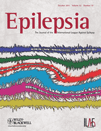Regional differences and secular trends in the incidence of epilepsy in Finland: A nationwide 23-year registry study
Summary
Purpose: Regional variations and temporal trends in the incidence of new-onset epilepsy are clinically important and may offer clues on how to prevent epilepsy.
Methods: We examined regional differences and secular trends in the incidence of new-onset epilepsy in the Finnish population based on the nationwide full-refundable antiepileptic drug registry and the population registry in the years 1986–2008.
Key Findings: The overall incidence of epilepsy was significantly higher in eastern Finland than in middle [risk ratio (RR) 1.08 (95% confidence interval, CI 1.05–1.12)), p < 0.0001] and western Finland [RR 1.32 (1.30–1.35), p < 0.0001] but it was declining from 1986 to 2008 in all regions [RR 0.83 (0.81–0.84), p < 0.0001]. The mean annual decline was 0.6%. Although the incidence of epilepsy was falling from 1986 to 2008 in childhood [annual decline 1.9%, RR 0.80 (0.75–0.86), p < 0.0001] and in middle age [annual decline 0.8%, RR 0.88 (0.84–0.93), p < 0.0001], it increased significantly in the elderly (age 65 years or older) in all of Finland [annual increase 3.5%, RR 1.25 (1.18–1.33), p < 0.0001], and particularly in east versus west Finland [RR 1.48 (1.42–1.55), p < 0.0001]. As a result, starting with the year 2000, the incidence rate of epilepsy was higher in the elderly than in children for all of Finland.
Significance: In view of the falling incidence of epilepsy in childhood and middle-age in all of Finland from 1986 to 2008, the significant increase in the incidence of epilepsy in the elderly is of concern. The regional increase of epilepsy may offer clues for allocating resources and, possibly, population epileptogenesis between west and east Finland and for strategies to prevent epilepsy in the elderly.




